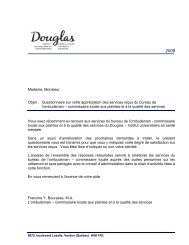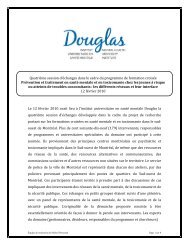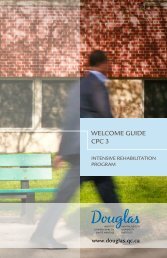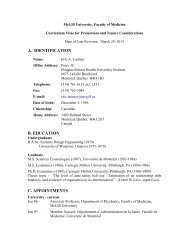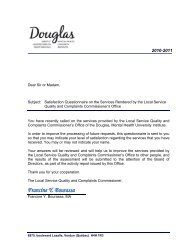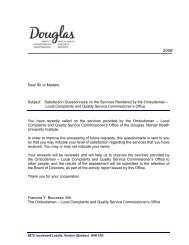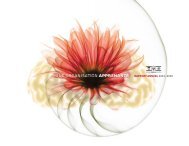Douglas.comm - Institut universitaire en santé mentale Douglas
Douglas.comm - Institut universitaire en santé mentale Douglas
Douglas.comm - Institut universitaire en santé mentale Douglas
Create successful ePaper yourself
Turn your PDF publications into a flip-book with our unique Google optimized e-Paper software.
L’audit des Plans thérapeutiques infirmiersTherapeutic Nursing Plan AuditEn janvier 2003, le gouvernem<strong>en</strong>tdu Québec <strong>en</strong>térinait la Loi n° 90 quiredéfinissait, <strong>en</strong>tre autres, le travail desinfirmières <strong>en</strong> matière d'évaluation clinique.Les modifications apportées à la Loi surles infirmières et les infirmiers introduisai<strong>en</strong>tla notion de plan thérapeutique infirmier(PTI). Le PTI est un docum<strong>en</strong>t qui permet der<strong>en</strong>dre facilem<strong>en</strong>t accessibles les décisionscliniques prises par l’infirmière sur la basede son évaluation et qui sont cruciales pourle suivi clinique du pati<strong>en</strong>t.« Avant, les décisions que pr<strong>en</strong>ai<strong>en</strong>t lesinfirmières n’apparaissai<strong>en</strong>t pas toujours auxdossiers des pati<strong>en</strong>ts, ou étai<strong>en</strong>t difficiles àtrouver. De plus, les plans de soins étai<strong>en</strong>tparfois rédigés au crayon, donc « effaçables ».Pourtant, les infirmières <strong>en</strong> sont imputableset ces décisions <strong>en</strong>gag<strong>en</strong>t leur responsabilitéprofessionnelle », déclare J<strong>en</strong>nifer Hague,infirmière clinici<strong>en</strong>ne <strong>en</strong> soins spécialiséset coordonnatrice du projet PTI à laDirection des soins infirmiers (DSI). « Grâceau PTI, toutes les décisions sont maint<strong>en</strong>antdocum<strong>en</strong>tées au dossier du pati<strong>en</strong>t.La sécurité et la qualité des soins infirmierss’<strong>en</strong> trouv<strong>en</strong>t grandem<strong>en</strong>t améliorés ».Les établissem<strong>en</strong>ts de santé du Québecavai<strong>en</strong>t jusqu’au 1 er avril 2009 pourimplanter le PTI. Au <strong>Douglas</strong>, la formationa débuté <strong>en</strong> novembre 2008 et, <strong>en</strong> cinqmois, 251 infirmières avai<strong>en</strong>t été formées.L’appr<strong>en</strong>tissage d’une nouvelle méthodede travail se fait rarem<strong>en</strong>t sans heurts.Toutefois, malgré quelques résistancesinitiales, les infirmières ont vite comprisles avantages de modifier leurs habitudesde travail <strong>en</strong> vue d’intégrer le PTI à leurpratique quotidi<strong>en</strong>ne. « Une formationcomposée de deux modes de diffusioncomplém<strong>en</strong>taires (<strong>en</strong> ligne et <strong>en</strong> salle declasse) a permis aux infirmières de pr<strong>en</strong>dre<strong>en</strong> main leur appr<strong>en</strong>tissage » expliqueSuzie Grégoire, conseillère <strong>en</strong> formationcontinue du Bureau de coordination del’<strong>en</strong>seignem<strong>en</strong>t et de la formation (BCEF).« Après la formation, chaque infirmièreassistait à au moins un atelier d’intégrationpratique d’<strong>en</strong>viron 90 minutes. SandraClergé, J<strong>en</strong>nifer Hague, Johanne RoyExemple de plan thérapeutique infirmier (PTI)et Régis Vill<strong>en</strong>euve de la DSI, aidés parCaroline Drolet et Guy Limoges, infirmièreet infirmier d’unité, se sont partagé la tâched’animer les ateliers le jour, le soir et la nuit, afin de joindre tous les quarts de travail. » Le personnel moinsfamilier avec la formation <strong>en</strong> ligne pouvait compter <strong>en</strong> tout temps sur le souti<strong>en</strong> de Claudette Carp<strong>en</strong>tier,technici<strong>en</strong>ne <strong>en</strong> <strong>comm</strong>unication du BCEF.Ce qui se mesure, se réaliseL’objectif de la DSI a été atteint quant au nombre d’infirmières formées (99 % du personnel infirmier).Il reste maint<strong>en</strong>ant à analyser la qualité des PTI et à évaluer si les infirmières :- complèt<strong>en</strong>t systématiquem<strong>en</strong>t un PTI pour chaque pati<strong>en</strong>t qui requiert un suivi clinique;- ont intégré les connaissances acquises lors des formations sur le PTI dans leur pratique;- sont satisfaites de la formation à deux volets qu’elles ont reçu.Depuis le 1 er juin, la DSI, appuyée par Steve Castonguay, conseiller cadre <strong>en</strong> mesures d’urg<strong>en</strong>ce et <strong>en</strong> qualitéà la Direction de la qualité, procède donc à un audit dont l’objectif est d’évaluer la qualité des PTI et leprocessus de formation. « Nous ne cherchons pas à évaluer individuellem<strong>en</strong>t chaque infirmière, mais bi<strong>en</strong>à assurer que la qualité des soins infirmiers est à un niveau désirable, dans les unités internes et externes,et à comparer nos activités avec les meilleures pratiques reconnues », souligne J<strong>en</strong>nifer Hague.« L’apport des infirmières est ess<strong>en</strong>tiel dans l’amélioration de la santé et dans la qualité des soins auprèsdes pati<strong>en</strong>ts. L’audit vise à assurer que le travail des infirmières s’appuie sur les meilleures pratiques et reflètela vision d’excell<strong>en</strong>ce du <strong>Douglas</strong> <strong>en</strong> matière de soins, d’<strong>en</strong>seignem<strong>en</strong>t et de recherche », conclut HélèneRacine, directrice des Soins infirmiers. L.M.In January 2003, the Quebecgovernm<strong>en</strong>t adopted Bill 90, whichredefined, among other things, theclinical evaluations performed bynurses. Am<strong>en</strong>dm<strong>en</strong>ts to the NursesAct introduced the concept of theTherapeutic Nursing Plan (TNP),a docum<strong>en</strong>t that makes it easy toaccess nurses’ evaluation-basedclinical decisions, which are ess<strong>en</strong>tialin pati<strong>en</strong>t follow-up.“Before, nurses’ decisions were notalways docum<strong>en</strong>ted in pati<strong>en</strong>trecords, or they were difficult to find.Care plans were sometimes writt<strong>en</strong> inp<strong>en</strong>cil and were therefore ‘erasable.’However, nurses are accountablefor their evaluations, and thesedecisions affect their professionalliability,” stated J<strong>en</strong>nifer Hague,a Clinical Nurse in specialized careand the coordinator of the TNPproject for the Nursing Directorate(ND). “Thanks to the TNP, alldecisions are now docum<strong>en</strong>tedin pati<strong>en</strong>t records. The safety andquality of nursing care are thereforegreatly improved.”Quebec health institutions had untilApril 1, 2009 to implem<strong>en</strong>t theTNP. At the <strong>Douglas</strong>, training onthe TNP started in November 2008,and 251 nurses were trained in5 months.Learning a new work method isseldom easy; however, despite someinitial resistance, the nurses quicklyunderstood the b<strong>en</strong>efits of changingtheir work habits in order to integratethe TNP into their daily practice.“A two-pronged training approach(on-line and in-class) helped nursestake charge of their own learningprocess,” explained Suzie Grégoire,a continuing education consultantfor the Teaching and TrainingCoordination Bureau (TTCB). “Afterthe training, each nurse att<strong>en</strong>dedat least one practical workshop ofExample of Therapeutic Nursing Plan (TNP) approximately 90 minutes. SandraClergé, J<strong>en</strong>nifer Hague, JohanneRoy and Régis Vill<strong>en</strong>euve from theND, assisted by unit nurses CarolineDrolet and Guy Limoges, shared the task of leading workshops for day, ev<strong>en</strong>ing and night staff to<strong>en</strong>sure that all shifts were covered.” Staff who were less familiar with on-line training could always callon the support of Claudette Carp<strong>en</strong>tier, a TTCB <strong>comm</strong>unications technician.What is measured gets doneThe ND’s target in terms of the number of nurses trained was met (99% of nurses). The only remainingtasks are an analysis of the quality of the TNPs and an evaluation of whether nurses:- Systematically complete a TNPs for each pati<strong>en</strong>t who requires clinical follow-up.- Have integrated the TNP training into their practice.- Are satisfied with the two types of training they received.Since June 1, the Nursing Directorate, in collaboration with Steve Castonguay, an emerg<strong>en</strong>cy measuresand quality consultant with the Quality Directorate, has be<strong>en</strong> conducting an audit to evaluate the qualityof the TNPs and the TNP training process. “Our aim is not to evaluate each nurse individually but ratherto <strong>en</strong>sure that the quality of nursing in the inpati<strong>en</strong>t and outpati<strong>en</strong>t units is at the desired level andto compare our activities with recognized best practices,” said J<strong>en</strong>nifer Hague.“The contribution of nurses is ess<strong>en</strong>tial in improving pati<strong>en</strong>t health and the quality of care theyreceive. The goal of this audit is to <strong>en</strong>sure that the work of nurses is based on best practices and reflectsthe <strong>Douglas</strong> <strong>Institut</strong>e’s vision of excell<strong>en</strong>ce in terms of care, teaching and research,” concluded HélèneRacine, Head of Nursing. L.M.L’audit s’échelonnera sur un peu plus de quatre mois,selon l'échéancier suivant :UnitésBurgess 1, Porteous 2C, CPC 2CPC 3, Porteous 1A, Troubles de l’alim<strong>en</strong>tationLevinschi, CML, Urg<strong>en</strong>ce/UIB, Soins int<strong>en</strong>sifsPerry 2A, Stearns, Burgess 2SRIC, Pédopsychiatrie (Lyall & Burland), TremplinCrossroadsTroubles de l’alim<strong>en</strong>tationQui fait l'évaluation? Qu'évalue-t-on? Comm<strong>en</strong>t?Infirmières et infirmiersInfirmières clinici<strong>en</strong>nes de laDirection des soins infirmiersInfirmières et infirmiers* L’audit des PTI <strong>en</strong> chiffres…Satisfaction à l’égard de laformation reçue (e-learninget ateliers pratiques) sur le PTICont<strong>en</strong>u des PTI complétéspar les infirmières *Intégration du PTI dansleur pratique quotidi<strong>en</strong>nePériode de l’audit1 er juin au 3 juillet13 juillet au 21 août27 juillet au 21 août10 août au 11 septembre17 août au 2 octobre14 septembre au 2 octobre21 septembre au 9 octobreQuestionnaire de satisfaction(anonyme) élaboré par le<strong>Douglas</strong>Instrum<strong>en</strong>t de vérificationdes PTI élaboré par l’Ordredes infirmières et infirmiersdu Québec (OIIQ)- Questionnaire anonymeélaboré par le <strong>Douglas</strong>- Discussions de suivi avecdes infirmières clinici<strong>en</strong>nes• Chaque PTI pr<strong>en</strong>d <strong>en</strong>viron 1 heure à vérifier par les infirmières clinici<strong>en</strong>nes• Chaque infirmière clinici<strong>en</strong>ne aura <strong>en</strong>viron 32 PTI à vérifier• Chaque infirmière clinici<strong>en</strong>ne disposera de 2 à 3 semaines pour vérifier les PTIsur une unité donnée (2 à 9 PTI par unité)• Les PTI seront évalués selon 51 critères élaborés par l’Ordre des infirmières et infirmiers du QuébecThe audit will be conducted over a little more than four monthsaccording to the following schedule:UnitsEvaluators? What? How?NursesClinical Nursing Specialistsfrom the Nursing DirectorateNursesSatisfaction with the TNPtraining received (e-learningand practical workshops)TNP cont<strong>en</strong>t completedby nurses*Integration of the TNPinto their daily practiceAudit periodBurgess 1, Porteous 2C, CPC 2 June 1 to July 3CPC 3, Porteous 1A, Eating Disorders July 13 to August 21Levinschi, CML, Emerg<strong>en</strong>cy/BIU, Int<strong>en</strong>sive care July 27 to August 21Perry 2A, Stearns, Burgess 2 August 10 to September 11SRIC, Child psychiatry (Lyall and Burland), Tremplin August 17 to October 2Crossroads September 14 to October 2Eating Disorders September 21 to October 9* The TNP audit in numbers …Satisfaction survey(anonymous) developedby the <strong>Douglas</strong>TNP verification instrum<strong>en</strong>tdeveloped by the Ordredes infirmières et infirmiersdu Québec (OIIQ)- Anonymous surveydeveloped by the <strong>Douglas</strong>- Follow-up discussionwith the Clinical NursingSpecialists• Each TNP takes about 1 hour to be verified by the Clinical Nursing Specialist (CNS)• Each CNS will have about 32 TNPs to verify• Each CNS will have 2 to 3 weeks to verify the TNPs for a specific unit (2 to 9 TNP per unit)• The TNPs will be evaluated based on 51 criteria developed by the Ordre des infirmièreset infirmiers du QuébecDupopiSeloélecà l’cliniDoupou« DadedeexpinfoProgcom1 etR<strong>en</strong>Unese réchle trFévrmondesMardesJuinl'orad'un« CEn alesTinPou<strong>Douglas</strong>.com juillet09.indd 4 17/07/09 11:50:42
itbecichthebyrsestheP),tosedtialnot<strong>en</strong>tnd.inle.’blees<strong>en</strong>alue,areNPatealltedndor<strong>en</strong>tiltheon08,inismeklyingateice.achrsesingire,antingfteredofdranetheinetocallingreslityherndeyctsèneMary CampbellLes auxiliaires du <strong>Douglas</strong> : 50 années de succès et de défisThe <strong>Douglas</strong> Auxiliary: 50 years of success and struggleLe Service des auxiliaires de l’<strong>Institut</strong> <strong>Douglas</strong> a été créé il y a 50 ans. Et ce fut tout un parcours. Les auxiliairesbénévoles se sont liés d’amitié avec des milliers de pati<strong>en</strong>ts de l’<strong>Institut</strong>, au cours des cinquante dernières années. Leurmandat, si simple et si noble, est d’améliorer la qualité de vie des pati<strong>en</strong>ts.À l’occasion du 50 e anniversaire du Service des auxiliaires bénévoles, sa présid<strong>en</strong>te, Mary Campbell,a gracieusem<strong>en</strong>t accepté de nous parler des défis que les auxiliaires ont eus à relever et des succès qu’ils ontremportés, hier et aujourd’hui.<strong>Douglas</strong>.<strong>comm</strong> : Mary, tout d’abord, félicitations à tous les auxiliaires bénévoles àl’occasion de leur 50 e anniversaire.M.C. : Merci! Année après année, les auxiliaires bénévoles offr<strong>en</strong>t généreusem<strong>en</strong>t leur temps et leurscompét<strong>en</strong>ces, et ils demeur<strong>en</strong>t fidèles, même <strong>en</strong> période difficile. Ce sont des héros méconnus de l’<strong>Institut</strong>.<strong>Douglas</strong>.<strong>comm</strong> : À propos des périodes difficiles, pourriez-vous nous donner une idéedes défis auxquels les auxiliaires ont dû faire face, lors de la création du service, <strong>en</strong> 1959?M.C. : Eh bi<strong>en</strong>, il y avait <strong>en</strong>viron 1 500 pati<strong>en</strong>ts, dont plusieurs vivai<strong>en</strong>t dans des unités verrouillées.Les besoins étai<strong>en</strong>t énormes. Dès le début, le mandat des auxiliaires a été conc<strong>en</strong>tré sur la satisfaction desbesoins quotidi<strong>en</strong>s des pati<strong>en</strong>ts. Notre « Magasin du coin » et notre « Casse-croûte » ont ouvert leurs portesà peu près à cette époque. Il y a eu de nombreux projets emballants : des excursions d’une journée et ducamping, des cadeaux pour tous les pati<strong>en</strong>ts à Noël, et un Programme de parrainage visant à créer des li<strong>en</strong>s<strong>en</strong>tre les membres du grand public et des pati<strong>en</strong>ts, pour n’<strong>en</strong> nommer que quelques-uns.<strong>Douglas</strong>.<strong>comm</strong> : L’<strong>Institut</strong> <strong>Douglas</strong> a changé du tout au tout, depuis ce temps. Parallèlem<strong>en</strong>tà cela, <strong>comm</strong><strong>en</strong>t les auxiliaires ont-ils évolué?M.C. : Même si la plupart des pati<strong>en</strong>ts de l’<strong>Institut</strong> viv<strong>en</strong>t maint<strong>en</strong>ant dans la collectivité, leurs besoins n’ontpas changé autant que vous pourriez le croire. Les auxiliaires bénévoles offr<strong>en</strong>t toujours du souti<strong>en</strong> affectifet des activités : <strong>en</strong> répondant à ces besoins fondam<strong>en</strong>taux, ils peuv<strong>en</strong>t transformer la vie de g<strong>en</strong>s atteintsde maladies m<strong>en</strong>tales graves. Et la totalité des sommes que nous recueillons est consacrée aux pati<strong>en</strong>ts.Combi<strong>en</strong> d’organismes bénévoles peuv<strong>en</strong>t <strong>en</strong> dire autant?<strong>Douglas</strong>.<strong>comm</strong> : Le service des auxiliaires a toujours été « l’<strong>en</strong>droit où aller »pour les pati<strong>en</strong>ts <strong>en</strong> quête d’aide financière à court terme et d’une oreille att<strong>en</strong>tive.M.C. : Supposons qu’un pati<strong>en</strong>t de l’<strong>Institut</strong> <strong>Douglas</strong> n’est pas <strong>en</strong> mesure de payer son loyer. Ou sa note d’épicerie.Ou son compte de téléphone. Il (ou elle) essaie vaillamm<strong>en</strong>t de vivre avec un faible rev<strong>en</strong>u, mais n’arrive pas àjoindre les deux bouts… C’est à ce mom<strong>en</strong>t-là que le personnel de l’<strong>Institut</strong> <strong>Douglas</strong> aiguille le pati<strong>en</strong>t vers lebureau des auxiliaires et nous demande un souti<strong>en</strong> financier. Les pati<strong>en</strong>ts vi<strong>en</strong>n<strong>en</strong>t parfois de leur propre chef nousdemander de l’aide. Ils sont bouleversés et effrayés. Nous faisons notre possible pour leur éviter des conséqu<strong>en</strong>cesstressantes et parfois dévastatrices (<strong>comm</strong>e perdre son appartem<strong>en</strong>t). C’est une grande partie de ce que nousfaisons. Nous aimerions aider davantage de pati<strong>en</strong>ts, mais il faut augm<strong>en</strong>ter le nombre de donateurs.<strong>Douglas</strong>.<strong>comm</strong> : Des dons de quel ordre vous faut-il?M.C. : Un don de 20 $ par année et par personne aiderait énormém<strong>en</strong>t. J’espère que les g<strong>en</strong>s qui liront cetarticle nous téléphoneront pour pr<strong>en</strong>dre cet <strong>en</strong>gagem<strong>en</strong>t. Il n’y a pas de façon plus facile d’aider les g<strong>en</strong>s quel'on côtoie tous les jours, et nous fournissons des reçus pour fins d’impôt.<strong>Douglas</strong>.<strong>comm</strong> : Quels sont les plus grands défis que vous ayez à relever, <strong>en</strong> ce mom<strong>en</strong>t?M.C. : Nos bénévoles pr<strong>en</strong>n<strong>en</strong>t de l’âge et il n’y a pas de relève. Par exemple, je suis présid<strong>en</strong>te depuis19 ans, et personne ne s’est prés<strong>en</strong>té pour me succéder. Et puis, nous gagnons moins d’arg<strong>en</strong>t que par le passé.De plus, nous déménageons. Le bureau des auxiliaires est déjà déménagé du pavillon Newman au pavillonPerry, et notre « Casse-croûte » et notre « Magasin du coin » <strong>en</strong> feront autant bi<strong>en</strong>tôt. Nous espérons quecela accroîtra notre visibilité et notre capacité à gagner de l’arg<strong>en</strong>t pour aider les pati<strong>en</strong>ts de l’<strong>Institut</strong> <strong>Douglas</strong>.N’hésitez pas à v<strong>en</strong>ir nous saluer. Nous aimerions beaucoup vous voir.<strong>Douglas</strong>.<strong>comm</strong> : En dépit des défis à relever, vous avez fait un don généreux de 30 000 $à l’<strong>Institut</strong> à l’occasion de votre anniversaire. Comm<strong>en</strong>t cette somme sera-t-elle utilisée?M.C. : En effet, nous avons fouillé dans le fond de nos poches pour faire ce don. Nous trouvions qu’il étaitimportant de souligner les 50 années d’aide que nous apportons aux pati<strong>en</strong>ts de <strong>Douglas</strong> par un donsubstantiel. Ces 30 000 $ serviront à construire une cuisine au pavillon Burgess. Le personnel utiliseraces installations pour <strong>en</strong>seigner aux pati<strong>en</strong>ts à cuisiner des repas sains et peu coûteux.<strong>Douglas</strong>.<strong>comm</strong> : En conclusion, quel message voulez-vous livrer à la <strong>comm</strong>unautéde l’<strong>Institut</strong> <strong>Douglas</strong>?M.C. : J’aimerais dire deux choses : premièrem<strong>en</strong>t, à tous les auxiliaires bénévoles, à Paul Cooke, qui nousfournit des bénévoles, et à tous ceux qui souti<strong>en</strong>n<strong>en</strong>t les auxiliaires, merci du fond du cœur. Deuxièmem<strong>en</strong>t,au personnel de l’<strong>Institut</strong> <strong>Douglas</strong>, permettez-moi de réitérer que le mom<strong>en</strong>t est idéal pour faire un don auxauxiliaires. Les temps sont durs pour tous. Alors, imaginez à quel point c’est difficile pour ceux qui sont atteintsd’une maladie m<strong>en</strong>tale grave!<strong>Douglas</strong>.<strong>comm</strong> : Comm<strong>en</strong>t doit-on s’y pr<strong>en</strong>dre, si on veut faire un don?M.C. : Vous n’avez qu’à rédiger un chèque au nom du Service des auxiliaires de l’<strong>Institut</strong> <strong>Douglas</strong>, et le posterà l’adresse de l’<strong>Institut</strong>, à mon att<strong>en</strong>tion. Veuillez vous assurer de nous fournir votre adresse. Soyez assurésde notre reconnaissance pour chaque chèque que nous recevrons. N.S.It’s be<strong>en</strong> 50 years since the <strong>Douglas</strong> Auxiliary was created. And what a journey it has be<strong>en</strong>. Auxiliaryvolunteers have befri<strong>en</strong>ded thousands of <strong>Douglas</strong> pati<strong>en</strong>ts over the past half c<strong>en</strong>tury. Their mandate---so simple and noble---is to improve our pati<strong>en</strong>ts’ quality of life.In honour of the Auxiliary’s 50th anniversary, Presid<strong>en</strong>t Mary Campbell has graciously agreedto speak about the Auxiliary’s chall<strong>en</strong>ges and successes, past and pres<strong>en</strong>t.<strong>Douglas</strong>.<strong>comm</strong>: Mary, first of all, congratulations to all Auxiliary volunteerson the 50 th anniversary.M.C.: Thank you! Year after year, Auxiliary volunteers give g<strong>en</strong>erously of their time andtal<strong>en</strong>ts, and remain loyal, ev<strong>en</strong> in chall<strong>en</strong>ging times. They are some of the unsung heroesof the <strong>Douglas</strong>.<strong>Douglas</strong>.<strong>comm</strong>: Speaking of chall<strong>en</strong>ging times, could you give us an idea ofwhat chall<strong>en</strong>ges the Auxiliary faced wh<strong>en</strong> it first op<strong>en</strong>ed its doors in 1959?M.C.: Well, there were approximately 1,500 pati<strong>en</strong>ts, many of whom lived on locked wards.The needs were <strong>en</strong>ormous. From the start, the Auxiliary’s mandate focused on meetingpati<strong>en</strong>ts’ everyday needs. Our Corner Store and Snack Bar op<strong>en</strong>ed around this time. Therewere many exciting initiatives: day trips and camping, gifts for all pati<strong>en</strong>ts at Christmastimeand a sponsorship program to create links betwe<strong>en</strong> members of the g<strong>en</strong>eral public and specificpati<strong>en</strong>ts, to name a few.<strong>Douglas</strong>.<strong>comm</strong>: The <strong>Douglas</strong> has changed radically since that time.How has the Auxiliary evolved in response?M.C.: Although most <strong>Douglas</strong> pati<strong>en</strong>ts now live in the <strong>comm</strong>unity, their needs hav<strong>en</strong>’t changedas much as you might think. Auxiliary volunteers still provide emotional support and activities—basic needs that can make a huge differ<strong>en</strong>ce in the lives of people with severe m<strong>en</strong>tal illness.And 100 perc<strong>en</strong>t of the money we raise goes to the pati<strong>en</strong>ts. How many volunteer organizationscan say that?<strong>Douglas</strong>.<strong>comm</strong>: The Auxiliary has always be<strong>en</strong> a “go-to” place for pati<strong>en</strong>tsin need of short-term financial help and someone to hear their troubles.M.C.: Let’s say a <strong>Douglas</strong> pati<strong>en</strong>t can’t pay the r<strong>en</strong>t. Or the grocery bill. Or the telephone bill.He (or she) is trying valiantly to live on a tiny income, but the numbers don’t add up…That’s wh<strong>en</strong> <strong>Douglas</strong> staff bring pati<strong>en</strong>ts to the Auxiliary office and ask us for financial support.Pati<strong>en</strong>ts also come on their own to ask for help. They’re upset and scared. We do our best to help themavoid stressful and pot<strong>en</strong>tially devastating consequ<strong>en</strong>ces (like losing their apartm<strong>en</strong>t). It’s a big partof what we do. We’d like to help more pati<strong>en</strong>ts, but we need to increase our number of donors.<strong>Douglas</strong>.<strong>comm</strong>: How much do you need?M.C.: A donation of $20 per year per person would make an amazing differ<strong>en</strong>ce. I’m hopingthat people reading this article will call us and make that <strong>comm</strong>itm<strong>en</strong>t. There’s no easier way tohelp the very people you’re working with every day, and we’ll provide you with a tax receipt too.<strong>Douglas</strong>.<strong>comm</strong>: What are some of your biggest chall<strong>en</strong>ges right now?M.C.: Our volunteers are getting older and new members ar<strong>en</strong>’t signing up to fill the ranks.For example, I’ve be<strong>en</strong> presid<strong>en</strong>t for 19 years and no one has stepped up to replace me.In addition, we are earning less money than in past years.We’re also moving. The Auxiliary officehas already moved from Newman Pavilion to Perry Pavilion, and our Snack Bar and Corner Storewill soon be based in Perry Pavilion too. We hope this will increase our visibility and our abilityto earn money to help <strong>Douglas</strong> pati<strong>en</strong>ts. By all means, come and say hello. We’d love to see you.<strong>Douglas</strong>.<strong>comm</strong>: Despite these chall<strong>en</strong>ges, you’ve made a g<strong>en</strong>erous $30,000donation to the <strong>Institut</strong>e in honour of your anniversary. How will the moneybe used?M.C.: Yes, we dug deep into our resources to make this donation. We felt it was importantto mark our 50th year of helping <strong>Douglas</strong> pati<strong>en</strong>ts with a major gift. The $30,000 will be usedto build a kitch<strong>en</strong> in Burgess Pavilion. Staff will use this facility to teach pati<strong>en</strong>ts how to cookhealthy, inexp<strong>en</strong>sive meals.<strong>Douglas</strong>.<strong>comm</strong>: In conclusion, what message do you want to pass onto the <strong>Douglas</strong> <strong>comm</strong>unity?M.C.: I’d like to say two things. First: to all Auxiliary volunteers, to Paul Cooke, who suppliesus with volunteers, and to all Auxiliary supporters, thank you from the bottomof my heart. Second: to <strong>Douglas</strong> staff, let me reiterate that this is an ideal time to donateto the Auxiliary. Times are tough for all of us. Imagine how much harder it is for thosewith a severe m<strong>en</strong>tal illness!<strong>Douglas</strong>.<strong>comm</strong>: What should people do if they want to make a donation?M.C.: Just write a cheque to the <strong>Douglas</strong> <strong>Institut</strong>e Auxiliary, and mail it to the <strong>Institut</strong>e addressto my att<strong>en</strong>tion. Please make sure you provide us with your address. We will be most gratefulfor every cheque we receive. N.S.Du pain sur la planchepour les trois équipespilotes du DPESelon l’échéancier d’implantation du Dossier pati<strong>en</strong>télectronique (DPE), la première phase sera franchieà l’automne 2009, lorsque le module « Visualiseurclinique » sera mis <strong>en</strong> place dans trois sites pilotes au<strong>Douglas</strong>. Grâce à ce module, le personnel cliniquepourra consulter les informations du dossier pati<strong>en</strong>t.« Dans un projet d’une telle <strong>en</strong>vergure, il est préférablede déployer le produit dans des sites pilotes afinde faire les ajustem<strong>en</strong>ts qui s’impos<strong>en</strong>t au début »,explique Claudine Houle, conseillère clinique à l’équipeinformatique. « Trois équipes dynamiques au sein duProgramme des troubles psychotiques ont été choisies<strong>comm</strong>e sites pilotes : l’équipe ACT, l’équipe du Burgess1 et la Clinique externe des troubles psychotiques ».R<strong>en</strong>contres m<strong>en</strong>suellesUne fois par mois, le personnel des sites pilotesse réunit ou va à la r<strong>en</strong>contre d’autres équipes, pouréchanger sur le projet et <strong>en</strong> appr<strong>en</strong>dre davantage surle travail au quotidi<strong>en</strong>.Février : visite des Archives. À noter : la voûte, lamontagne de papiers à classer et un dossier pati<strong>en</strong>tdes années 1890.Mars : visite du Burgess 1. À noter : le dévouem<strong>en</strong>tdes clinici<strong>en</strong>s.Juin : visite de la clinique externe l'Étape. À noter :l'orage électrique impressionnant et l'interv<strong>en</strong>tion rapided'un clinici<strong>en</strong> pour rassurer un pati<strong>en</strong>t inquiet.« Cartographie »En avril, mai et juin, les trois équipes pilotes ont analyséles processus cliniques actuels, sous la direction deTin Quach, spécialiste <strong>en</strong> amélioration des processus.Pour <strong>en</strong> savoir davantage sur le DPE, visitez l'intranet.L.M.L’équipe de direction des sitespilotes : Michel Laverdure,chef de programmedes troubles psychotiques;Evangeline Smithet Ina Winkelmann,chefs clinico-administratifs.Franco Plaiche, infirmier auBurgess 1,est nommé représ<strong>en</strong>tantofficiel des sites pilotes.L'équipe ACT.Dans l’ordre habituel :Joseph Thavundayil, M.D.;Ina Winkelmann; Grant Stev<strong>en</strong>son;Debbie Nasheim.L’équipe de la Clinique externe.À l’avant : Claudine Poulin,Mélanie Caillé, Josée Perreault,Mélissa Carbone. À l’arrière :Tammy Reeves, Franco Plaiche, TinQuach, Kathle<strong>en</strong> Madd<strong>en</strong> (chargéede projet DPE), Diane Leblanc,MinHa Tran et Évangeline Smith.L’équipe du Burgess 1 :Isabelle Carrier,Marcia DaSilva,Tin Quach,Chito Ferrer,Caril Toussaintet Anna Scardocchio.The pilot site managem<strong>en</strong>tteam: Michel Laverdure,Program Chief,Psychotic DisordersProgram; Evangeline Smithand Ina Winkelmann,Clinical-administrative Chiefs.Franco Plaiche, a Burgess 1 nurse,was appointed as the officialrepres<strong>en</strong>tative for the pilot sites.The ACT team.From left to right:Joseph Thavundayil, MD;Ina Winkelmann; Grant Stev<strong>en</strong>son;Debbie Nasheim.The Outpati<strong>en</strong>t Clinic team.In front: Claudine Poulin, MélanieCaillé, Josée Perreault, MélissaCarbone. In back: Tammy Reeves,Franco Plaiche, Tin Quach, Kathle<strong>en</strong>Madd<strong>en</strong> (EPR Project Manager),Diane Leblanc, MinHa Tranand Évangeline Smith.The Burgess 1 team:Isabel Carrier,Marcia DaSilva,Tin Quach,Chito Ferrer,Caril Toussaintand Anna Scardocchio.Three EPR pilotteams have a loton their platesThe first phase of the implem<strong>en</strong>tation for theElectronic Pati<strong>en</strong>t Record (EPR) will begin inautumn 2009, wh<strong>en</strong> the “Clinical Display” modulewill be set up at three pilot sites at the <strong>Douglas</strong>.This module will allow clinical staff to consultinformation from pati<strong>en</strong>t records. “For a projectof this size, we need to deploy the product at pilotsites so we can make any necessary adjustm<strong>en</strong>tsfrom the beginning,” explained Claudine Houle,a clinical advisor to the IT team. “Three great teamsin the Psychotic Disorders Program were chos<strong>en</strong> forthe pilot project: the ACT team, the Burgess 1 team,and the Psychotic Disorders Outpati<strong>en</strong>t Clinic.”Monthly sessionsOnce a month, staff at the pilot sites hold meetingsor att<strong>en</strong>d the meetings of other teams to discuss theproject and learn more about how it will integrateinto their daily work.February: visit of Medical Records. Notable:storage vault, mountain of docum<strong>en</strong>ts to file andold pati<strong>en</strong>t record from the 1890s.March: visit of Burgess 1. Notable: clinicians'<strong>comm</strong>itm<strong>en</strong>t to their work.June: visit of l'Étape outpati<strong>en</strong>t clinic. Notable:major electrical storm and quick interv<strong>en</strong>tion by aclinician to reassure a worried pati<strong>en</strong>t.“Mapping”In April, May and June, the three pilot teams analyzedcurr<strong>en</strong>t clinical processes under the supervisionof Tin Quach, a process improvem<strong>en</strong>t specialist.For more information on the EPR, visit the intranet.L.M.<strong>Douglas</strong>.com juillet09.indd 5 17/07/09 11:50:43
Suite de la uneAprès avoir subi une perte,Kimberly Eyquem travailleà faire naître l’espoirEn un mot ou deux…• Qu’est-ce qui décrit le mieuxla maladie m<strong>en</strong>tale? Il s’agitd’une distorsion de la perceptionde soi ou de sa situation, qui estassez puissante pour perturbergravem<strong>en</strong>t son aptitude às’<strong>en</strong>gager dans une vie saine oudans des relations humaines.• Quel est le film qui a le plusinflu<strong>en</strong>cé vos idées sur lasanté m<strong>en</strong>tale? Girl Interrupted(Une vie volée) : c’est le premierfilm que j’ai vu qui se p<strong>en</strong>chaitsur les formes moins « int<strong>en</strong>ses »ou stéréotypées de la maladiem<strong>en</strong>tale, et cela m’a permis deme r<strong>en</strong>dre compte que c’étaitquelque chose qui pouvaittoucher n’importe qui, quel quesoit le sexe, l’âge ou la situation.• Comm<strong>en</strong>t maint<strong>en</strong>ez-vous unevie équilibrée? Je m’efforce defaire passer ma famille <strong>en</strong>premier, et de maint<strong>en</strong>ir desli<strong>en</strong>s étroits avec les g<strong>en</strong>s et lesc<strong>en</strong>tres d’intérêt qui nourriss<strong>en</strong>tles aspects non professionnels dema vie. Et j’essaie de rire autant etaussi souv<strong>en</strong>t que possible.• Qui accomplit un travail remarquabledans la démystificationde la maladie m<strong>en</strong>tale?L’<strong>Institut</strong> <strong>Douglas</strong> a vraim<strong>en</strong>tfait œuvre d’innovation <strong>en</strong>prés<strong>en</strong>tant la maladie m<strong>en</strong>taleau grand public par desprogrammes <strong>comm</strong>e l’ÉcoleMini Psy et Vues de l’esprit.J’apprécie aussi beaucoup letravail effectué par CAMH pourdémystifier la maladie m<strong>en</strong>tale.• Dans 125 ans, l’<strong>Institut</strong> <strong>Douglas</strong>sera-t-il <strong>en</strong>core là? Je dirais queoui, sous une forme ou une autre.J’ai de la difficulté à croire quedans 125 ans, nous connaîtronstout ce qu’il y a à connaître surle cerveau humain.• Un mot pour décrire l’<strong>Institut</strong><strong>Douglas</strong>? Espoir.Re-découverte du portrait d’un MolsonVous savez sûrem<strong>en</strong>t que la famille Molson a acheté récemm<strong>en</strong>tle club de hockey des Canadi<strong>en</strong>s de Montréal. Mais, saviez-vousque nous avons nos propres nouvelles concernant les Molson?Tout a <strong>comm</strong><strong>en</strong>cé il y a quelques mois, lorsque StéphanieLassonde, responsable du à l’<strong>Institut</strong> <strong>Douglas</strong>, cherchait quelquechose pour égayer les murs de son bureau. Elle savait qu’elle avaittrouvé son trésor lorsqu’elle a découvert le portrait d’un monsieurà l’air distingué, caché dans un coin de l’<strong>Institut</strong>.Elle prit le portrait, et l’accrocha à son mur. Le l<strong>en</strong>demain, l’unde ses consultants – ferv<strong>en</strong>t amateur d’art – lui r<strong>en</strong>dit visite.« Qui est cet homme? », demanda-t-il. « Quel li<strong>en</strong> a-t-il avecl’<strong>Institut</strong> <strong>Douglas</strong>? »Intrigués, ils décidèr<strong>en</strong>t de trouver l’id<strong>en</strong>tité de l’hommemystérieux et du peintre qui avait signé son portrait. Leur principalindice était effectivem<strong>en</strong>t la signature : Robert Harris.Quelques rapides courriels à Brian Foss, professeur auDépartem<strong>en</strong>t d’histoire de l’art à l’Université Concordia,et à Conrad Graham, conservateur des arts décoratifs auMusée McCord, leur ont permis de trouver la réponse :non seulem<strong>en</strong>t ce tableau constituait-il une partie importantede l’histoire de l’<strong>Institut</strong> <strong>Douglas</strong>, mais il avait <strong>en</strong> outre été peintpar l’un des plus grands portraitistes du Canada.Petite leçon d'histoirePremièrem<strong>en</strong>t, le modèle : le portrait est celui de nul autre queJohn H<strong>en</strong>ry Robinson Molson (1826–1897), le petit-fils de JohnMolson, qui lança la Brasserie Molson dans les années 1780.L’apport de John H. R. Molson à sa chère ville de Montréalrelève de la lég<strong>en</strong>de. En fait, il a tellem<strong>en</strong>t donné spontaném<strong>en</strong>tde son temps et de son arg<strong>en</strong>t à l’Université McGill, qu’il s’estfait offrir le poste de chancelier (qu’il a modestem<strong>en</strong>t refusé).Stéphanie Lassonde devant le portrait de John H.R. MolsonEt il a égalem<strong>en</strong>t été extrêmem<strong>en</strong>t généreux à l’égard du VerdunProtestant Hospital for the Insane (nom original de l’<strong>Institut</strong>).En plus d’avoir été l’un des fondateurs de l’Hôpital, il afait des dons importants, notamm<strong>en</strong>t des fonds destinésà la construction d’un pavillon et d’un gymnase. Pour lespati<strong>en</strong>ts de l’époque, dont les principaux traitem<strong>en</strong>ts étai<strong>en</strong>t constitués d’activitéset de grand air, ces immeubles étai<strong>en</strong>t une bénédiction. Malheureusem<strong>en</strong>t,ces édifices n’exist<strong>en</strong>t plus aujourd’hui.Deuxièmem<strong>en</strong>t, le peintre : Robert Harris, l’un des plus grands portraitistes du Canada,est surtout connu pour son portrait des Pères de la Confédération, un classique de l’histoiredu Canada, peint <strong>en</strong> 1883.Harris a réalisé le portrait de John H. R. Molson <strong>en</strong> 1907, probablem<strong>en</strong>t d’après unephotographie, car John H. R. Molson s’est éteint <strong>en</strong> 1897. Harris fut payé 400 $ pour sontravail, somme importante pour l’époque.À mesure que l’information s’accumule à propos du portrait, la curiosité de Stéphanieaugm<strong>en</strong>te : « Je me pose la question : combi<strong>en</strong> d’employés de l’<strong>Institut</strong> <strong>Douglas</strong> ont admirécette œuvre, au cours du dernier siècle? Combi<strong>en</strong> de personnes l’ont accroché dans leurbureau au fil des ans, <strong>comm</strong>e je l’ai fait? Chose certaine, John H<strong>en</strong>ry Robinson Molson seraitfier de voir l’évolution du <strong>Douglas</strong> depuis 100 ans. Ce portrait de M. Molson nous rappell<strong>en</strong>os racines. Ri<strong>en</strong> que cela <strong>en</strong> fait une pièce inestimable de l’histoire de l’<strong>Institut</strong>. J’espèrele voir exposé au <strong>Douglas</strong> au cours des prochains mois, afin que tous puiss<strong>en</strong>t <strong>en</strong> profiter. »N.S.Stéphanie Lassonde beside the portrait of John H.R. Molson« Fathers of Confederation » par Robert Harris“Fathers of Confederation” by Robert HarrisMolson portrait rediscoveredNo doubt you know that the Molson family rec<strong>en</strong>tlypurchased the Montreal Canadi<strong>en</strong>s hockey team. But did youknow that we have our very own Molson-related news?It all began a few months ago, wh<strong>en</strong> Head ofCommunications, Stéphanie Lassonde, was on the huntfor something to bright<strong>en</strong> her office walls. She knewshe had struck gold wh<strong>en</strong> she discovered a portrait of adistinguished-looking g<strong>en</strong>tleman, tucked away in a cornerof the <strong>Institut</strong>e.She picked him up and hung him in her office. The nextday, one of her consultants, an avid art lover, walked intoher office.“Who is that fellow?” he asked, “And what is his<strong>Douglas</strong> connection?”Intrigued, the two of them decided to track down theid<strong>en</strong>tity of the mystery man and the artist who hadpainted him. Their main clue was the artist’s name: RobertHarris.A few quick e-mails to Concordia University Departm<strong>en</strong>tof Art History professor Brian Foss and the McCordMuseum’s Curator of Decorative Arts, Conrad Graham,and they had their answer. Not only was this painting animportant part of <strong>Douglas</strong> history, it was painted by oneof Canada’s greatest portrait artists.A bit of historyFirst, to the g<strong>en</strong>tleman: the portrait is of none other thanJohn H<strong>en</strong>ry Robinson Molson (1826–1897), the grandsonof John Molson, who started the Molson’s brewingbusiness in the 1780s.John H. R. Molson’s contributions to his beloved Montréalare the stuff of leg<strong>en</strong>d. In fact, he gave so freely of histime and money to McGill University, he was offered theposition of Chancellor (which he modestly declined).To the Verdun Protestant Hospital for the Insane(the original name of our <strong>Institut</strong>e), he was also amazinglyg<strong>en</strong>erous. In addition to being a founding father of thehospital, he gave many gifts, including funds at the turn of the tw<strong>en</strong>tieth c<strong>en</strong>turyto erect a pavilion and gymnasium. For the pati<strong>en</strong>ts at the time, whose primarytreatm<strong>en</strong>t was activity and fresh air, these buildings were a gods<strong>en</strong>d. Unfortunately,they are no longer standing today.Now, to the artist: Robert Harris, one of Canada’s acclaimed portrait painters, is bestknownfor his 1883 painting of the Fathers of Confederation—a Canadian classic.He painted the John H. R. Molson portrait in 1907—probably from a photograph,since John H. R. Molson died in 1897. Harris was paid $400 for his efforts—a tidysum at the time.As facts pour in about the portrait, Stéphanie’s curiosity continues to grow,“It makes me wonder, ‘How many <strong>Douglas</strong> employees have admired this workover the last c<strong>en</strong>tury? How many people have hung it in their offices and corridorsover the years, just like I did? One thing is clear: John H<strong>en</strong>ry Robinson Molsonwould be proud to see how far we’ve tak<strong>en</strong> the <strong>Douglas</strong> in the past c<strong>en</strong>tury. Wh<strong>en</strong>we look at Mr. Molson, we are reminded of our roots. That alone makes it apriceless piece of <strong>Douglas</strong> history. I hope to see it displayed at the <strong>Douglas</strong> in thecoming months, for all to <strong>en</strong>joy.” N.S.Continued from cover pageIn loss, Kimberly Eyquemworks at building hopeIn a Word or Two …• What words best describem<strong>en</strong>tal illness? A distortionin the perception of one's selfor one's circumstances thatis suffici<strong>en</strong>tly powerful toseriously disrupt one's abilityto <strong>en</strong>gage healthily in life andin human relationships.• What film has most influ<strong>en</strong>cedyour thoughts on m<strong>en</strong>talhealth? Girl Interrupted - itwas the first film I saw thataddressed the less 'int<strong>en</strong>se' orstereotypical forms of m<strong>en</strong>talillness, and it made merealize that it was somethingthat could affect anyone,regardless of their g<strong>en</strong>der, ageor circumstance.• How do you maintain abalanced lifestyle? I workhard at putting my family first,and maintaining close tieswith people and interests thatnourish 'non-work' aspects oflife. And I try to laugh as muchand as oft<strong>en</strong> as possible.• Who is doing outstandingwork in destigmatizingm<strong>en</strong>tal illness? The <strong>Douglas</strong>has really be<strong>en</strong> an innovator inbringing m<strong>en</strong>tal illness into themainstream through programslike Mini-Psych and Frames ofMind. I also really appreciatethe work that CAMH has doneto destigmatize m<strong>en</strong>tal illness.• In 125 years, will the <strong>Douglas</strong>still be here? I would sayyes, in one form or another -I find it difficult to believe that,ev<strong>en</strong> in 125 years, we'll knowall there is to know about thehuman brain.• One word that describes the<strong>Douglas</strong>? Hope.Suite de la uneEll<strong>en</strong> Corin : une carrière à établir des pontsLa « porte tournante » de la schizophrénieEll<strong>en</strong> Corin a rapidem<strong>en</strong>t appliqué ce jugem<strong>en</strong>t critique à la schizophrénie. À l’époque,précise-t-elle, à peu près la moitié des pati<strong>en</strong>ts schizophrènes admis dans des hôpitauxdu Québec, étai<strong>en</strong>t réadmis quelques mois plus tard. « Il y avait cette porte tournantede g<strong>en</strong>s qui <strong>en</strong>trai<strong>en</strong>t à l’hôpital et <strong>en</strong> ressortai<strong>en</strong>t constamm<strong>en</strong>t. Je voulais trouver ce quiaide les pati<strong>en</strong>ts à demeurer dans la société. Et ce qui les ramène à l’hôpital. »Ell<strong>en</strong> explique qu’à l’époque, selon le schème de p<strong>en</strong>sée traditionnel, les pati<strong>en</strong>tsschizophrènes qui disposai<strong>en</strong>t d’un solide réseau social – famille <strong>en</strong>gagée et amis proches –s’intégrai<strong>en</strong>t mieux à la société que ceux qui étai<strong>en</strong>t isolés. Mais Ell<strong>en</strong> Corin a constaté quede nombreux schizophrènes qui fréqu<strong>en</strong>tai<strong>en</strong>t les parcs, les coins de rue et même les cafés,où ils se trouvai<strong>en</strong>t <strong>en</strong> société, n’étai<strong>en</strong>t cep<strong>en</strong>dant pas forcés de s’y <strong>en</strong>gager.« Retrait positif »Cette simple observation – <strong>en</strong> plus des nombreuses heures d’<strong>en</strong>trevues avec des pati<strong>en</strong>ts– a m<strong>en</strong>é à l’idée de « retrait positif », changem<strong>en</strong>t fondam<strong>en</strong>tal de la perceptionde cet aspect du comportem<strong>en</strong>t schizophrénique, et de la façon dont il pourrait être mieuxcompris. La p<strong>en</strong>sée traditionnelle appelait à une augm<strong>en</strong>tation du souti<strong>en</strong> social offert auxpati<strong>en</strong>ts schizophrènes, ce qui signifiait un accroissem<strong>en</strong>t de l’intégration et du nombrede « rôles » sociaux à jouer pour le pati<strong>en</strong>t. Le retrait positif, par contre, leur permettait de« se construire un espace intérieur protégé, et d’observer la vie d’un point de vue tranquille »,ajoute-t-elle. « Dans le traitem<strong>en</strong>t des pati<strong>en</strong>ts schizophrènes, il faut t<strong>en</strong>ir comptedes rapports particuliers qu’ils <strong>en</strong>treti<strong>en</strong>n<strong>en</strong>t avec eux-mêmes et avec le monde, plutôt quede les forcer à vivre une vie que nous percevons <strong>comm</strong>e plus valable, selon nos normes. »Parallèlem<strong>en</strong>t à ce travail, elle participait à des études <strong>en</strong> Abitibi, au Brésil, <strong>en</strong> Afriquesubsahari<strong>en</strong>ne et <strong>en</strong> Inde, sur la maladie m<strong>en</strong>tale et la vie <strong>comm</strong>unautaire. Ess<strong>en</strong>tiellem<strong>en</strong>t,elle t<strong>en</strong>tait de découvrir la façon dont les pati<strong>en</strong>ts atteints de maladies m<strong>en</strong>tales voyai<strong>en</strong>tleur propre expéri<strong>en</strong>ce et la façon dont les membres de leur société réagissai<strong>en</strong>t face àeux, afin d’adapter les programmes locaux à leur situation. Le pronostic pour les pati<strong>en</strong>tsschizophrènes est meilleur dans certaines sociétés que dans d’autres; par exemple, Ell<strong>en</strong> croitque le milieu très religieux de l’Inde peut être une bénédiction pour les pati<strong>en</strong>ts. Mais quellesqu’ai<strong>en</strong>t été ses intuitions, et où qu’elle ait travaillé, Ell<strong>en</strong> s’est assurée d’utiliser les systèmesde souti<strong>en</strong> tels qu’ils étai<strong>en</strong>t, sans imposer ses méthodes aux collectivités.Les « Impati<strong>en</strong>ts »Comptant sur l’extériorisation des pati<strong>en</strong>ts pour compr<strong>en</strong>dre leurs besoins, il étaitnaturel qu'Ell<strong>en</strong> se soit <strong>en</strong>gagée, au cours des dernières années, avec les « Impati<strong>en</strong>ts »,un c<strong>en</strong>tre qui incite les pati<strong>en</strong>ts atteints de maladie m<strong>en</strong>tale à s’exprimer au moy<strong>en</strong> de l’art.« La collaboration <strong>en</strong>tre Les Impati<strong>en</strong>ts et le <strong>Douglas</strong> n’<strong>en</strong> est qu’à ses débuts. Bi<strong>en</strong> qu’Ell<strong>en</strong>pr<strong>en</strong>ne sa retraite, nous ferons appel à son souti<strong>en</strong>, à ses opinions et à ses suggestions pourfaire évoluer cette collaboration », confie Rémi Quirion, Ph.D., directeur sci<strong>en</strong>tifique duC<strong>en</strong>tre de recherche du <strong>Douglas</strong>.Rémi Quirion n’a pas à s’<strong>en</strong> faire. Ell<strong>en</strong> Corin n’a pas l’int<strong>en</strong>tion de cesser de travailler,même à la retraite. « La maladie m<strong>en</strong>tale est universelle, et la psychose est universellem<strong>en</strong>teffrayante, dit-elle. Étudier la schizophrénie, à grande échelle, au niveau mondial, ne nousaide pas uniquem<strong>en</strong>t à compr<strong>en</strong>dre la maladie, mais à nous compr<strong>en</strong>dre nous-mêmes.En examinant la psychose d’une façon plus approfondie, et ce qu’elle peut nous <strong>en</strong>seignersur nous-mêmes, nous <strong>en</strong> appr<strong>en</strong>ons davantage sur la dim<strong>en</strong>sion tragique de ce que c’est,d’être un humain. » M.R.Continued from cover pageEll<strong>en</strong> Corin: a career sp<strong>en</strong>t building bridgesThe “revolving door” of schizophr<strong>en</strong>iaEll<strong>en</strong> Corin soon applied that critical judgm<strong>en</strong>t to schizophr<strong>en</strong>ia. At the time,she explained, a large proportion of all schizophr<strong>en</strong>ia pati<strong>en</strong>ts admitted toQuebec’s hospitals would <strong>en</strong>d up being readmitted within months. “There wasthis revolving door of people in and out of the hospital. I wanted to find whatis helping these pati<strong>en</strong>ts remain in society? What is pushing them back?”Ell<strong>en</strong> explains that at the time, conv<strong>en</strong>tional thinking held that schizophr<strong>en</strong>icpati<strong>en</strong>ts with strong social networks – <strong>en</strong>gaged families and close fri<strong>en</strong>ds – wouldintegrate into society better than their more isolated peers. She noted, however,that many schizophr<strong>en</strong>ics would frequ<strong>en</strong>t parks, street corners, and ev<strong>en</strong> cafés,where they were in society, but not forced to <strong>en</strong>gage in it.“Positive Withdrawal”This simple observation – plus many hours of interviews with pati<strong>en</strong>ts – led to theidea of “Positive Withdrawal,” a fundam<strong>en</strong>tal shift in perception of this aspectof schizophr<strong>en</strong>ic behaviour, and how it might best be understood. Conv<strong>en</strong>tionalviews called for more social support for schizophr<strong>en</strong>ic pati<strong>en</strong>ts, which meant moreintegration, and more social roles for the pati<strong>en</strong>t to play. Positive Withdrawal,on the other hand, allowed them to “build an inner space that was protected,and for them to look at life from a quiet perspective,” she explains.“In treatingschizophr<strong>en</strong>ic pati<strong>en</strong>ts, one has to take into account their own way to relateto themselves and to the world rather than forcing them into a life that weperceive as more valuable with our own standards.”Parallel to this work, she was participating in studies in Abitibi, Brazil, sub-SaharanAfrica and India on m<strong>en</strong>tal illness and <strong>comm</strong>unity life. Fundam<strong>en</strong>tally, she wastrying to find how pati<strong>en</strong>ts with m<strong>en</strong>tal illness saw their own experi<strong>en</strong>ce, and howother members of their society reacted to them, in order to adjust local programsfor them. The prognosis for schizophr<strong>en</strong>ic pati<strong>en</strong>ts is better in some countries thanothers; for example, Ell<strong>en</strong> Corin believes India’s strongly religious <strong>en</strong>vironm<strong>en</strong>tcan be a boon for pati<strong>en</strong>ts there. But whatever her insights and wherever sheworked, Ell<strong>en</strong> made absolutely certain to work within the support systems as theywere, without imposing her methods on the <strong>comm</strong>unities.“Les Impati<strong>en</strong>ts”With her emphasis on relying on her pati<strong>en</strong>t’s self-expression to understandtheir needs, it was natural that Ell<strong>en</strong> has, in rec<strong>en</strong>t years, become involvedwith “Les Impati<strong>en</strong>ts,” a c<strong>en</strong>tre that <strong>en</strong>courages m<strong>en</strong>tally ill pati<strong>en</strong>ts to expressthemselves through art. “The collaboration betwe<strong>en</strong> Les Impati<strong>en</strong>ts andthe <strong>Douglas</strong> is just beginning. Though Ell<strong>en</strong> is retiring, we will rely on hersupport, her opinions and her suggestions to further develop the relationship,”says Remi Quirion, PhD, Sci<strong>en</strong>tific Director of the <strong>Douglas</strong> Research C<strong>en</strong>tre.Rémi Quirion can rest easy. Ell<strong>en</strong> Corin has no int<strong>en</strong>tion of stopping work, ev<strong>en</strong>in retirem<strong>en</strong>t. “The experi<strong>en</strong>ce of m<strong>en</strong>tal illness is universal, and the experi<strong>en</strong>ceof psychosis is universally fright<strong>en</strong>ing, she says. Studying schizophr<strong>en</strong>ia, in awide-ranging, global way does not just to help us understand the illness, butourselves. In looking in a deeper way at psychosis and what can it teach us aboutus, we learn about the tragic dim<strong>en</strong>sion of what it means to be human.” M.R.• douglas.<strong>comm</strong> est publié quatre fois par année par le Service des <strong>comm</strong>unications et affaires publiques de l’<strong>Institut</strong> <strong>Douglas</strong> • Chef de service : Stéphanie Lassonde, 514 761-6131 (poste 2747), stephanie.lassonde@douglas.mcgill.ca • Rédactrice <strong>en</strong> chef : Lyna Morin, 514 761-6131 (poste 2770), lyna.morin@douglas.mcgill.ca• Rédactrices : Julia Asselstine, Lyna Morin, Mark Reynolds, Nancy Schmidt • Traducteurs : Amy Butcher, Louise Sasseville • Révision : Lyna Morin • Conception graphique : Alibi Acapella • À noter : Le générique masculin est utilisé dans le seul but de faciliter la lecture et désigne aussi bi<strong>en</strong> les hommes que les femmes • Ce bulletin estproduit par l’<strong>Institut</strong> <strong>Douglas</strong>, 6875, boul. LaSalle, Montréal (Québec) Canada H4H 1R3.• douglas.<strong>comm</strong> is published quarterly by the Communications and Public Affairs Departm<strong>en</strong>t of the <strong>Douglas</strong> <strong>Institut</strong>e • Departm<strong>en</strong>t Head: Stéphanie Lassonde, 514 761-6131 (ext. 2747), stephanie.lassonde@douglas.mcgill.ca • Chief Editor: Lyna Morin, 514 761-6131 (ext. 2770), lyna.morin@douglas.mcgill.ca • Writers:Julia Asselstine, Lyna Morin, Mark Reynolds, Nancy Schmidt • Translators: Amy Butcher, Louise Sasseville • Revision: Lyna Morin • Graphic design: Alibi Acapella • Please note: The male g<strong>en</strong>der is used merely to facilitate reading and implies both m<strong>en</strong> and wom<strong>en</strong>. This newsletter is produced by the <strong>Douglas</strong> <strong>Institut</strong>e,6875 LaSalle Blvd., Montréal, Quebec, Canada H4H 1R3<strong>Douglas</strong>.com juillet09.indd 6 17/07/09 11:50:44



